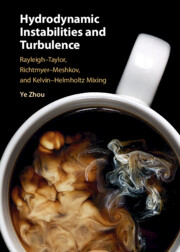 Hydrodynamic Instabilities and Turbulence
Hydrodynamic Instabilities and Turbulence Book contents
- Frontmatter
- Dedication
- Contents
- Preface
- Acknowledgments
- Part 1 Fundamentals
- Part 2 Hydrodynamics of Complex Flows
- Part 3 From the Microscopic to Cosmic Scales
- 18 High-energy-density physics
- 19 Inertial confinement fusion implosion
- 20 Laboratory applications
- 21 Astrophysical and space applications
- 22 Mixmodels
- 23 Numerical simulations of mixing
- 24 Does 2D turbulence resemble 3D turbulence?
- References
- Index
20 - Laboratory applications
from Part 3 - From the Microscopic to Cosmic Scales
- Frontmatter
- Dedication
- Contents
- Preface
- Acknowledgments
- Part 1 Fundamentals
- Part 2 Hydrodynamics of Complex Flows
- Part 3 From the Microscopic to Cosmic Scales
- 18 High-energy-density physics
- 19 Inertial confinement fusion implosion
- 20 Laboratory applications
- 21 Astrophysical and space applications
- 22 Mixmodels
- 23 Numerical simulations of mixing
- 24 Does 2D turbulence resemble 3D turbulence?
- References
- Index
Summary
Material strength is important for planetary science and planetary formation dynamics. Inspecting RTI growth in solid-state samples in a high-energy-density setting can be key to determining the strength of a number of materials, such as iron, lead, or tantalum. One of the important applications is the enhanced mixing in the scramjet; I will address this issue as well as detonation in the combustion chamber. Moreover, I will discuss the reactive RMI in detail to address several issues related to turbulence-flame interactions, such as an incident shock wave passing the interface and shock initiation of flow instabilities. Ejecta occurs when small pieces of the material are forced out as a result of stellar explosions or other sharp impacts in the engineering process. RMI is key to understanding the physics processes for the production and distribution of ejecta. Extensive data from numeric simulations and experimental evidence will be offered to provide a comprehensive picture about this topic.
- Type
- Chapter
- Information
- Hydrodynamic Instabilities and TurbulenceRayleigh–Taylor, Richtmyer–Meshkov, and Kelvin–Helmholtz Mixing, pp. 407 - 441Publisher: Cambridge University PressPrint publication year: 2024
